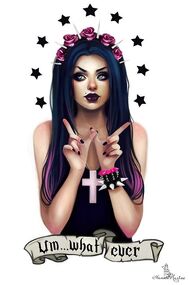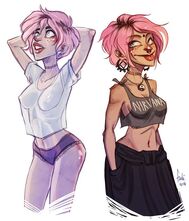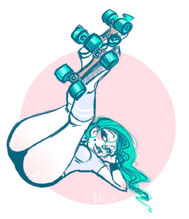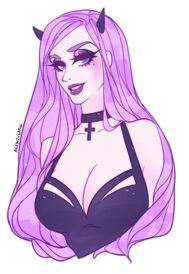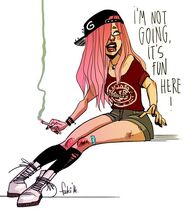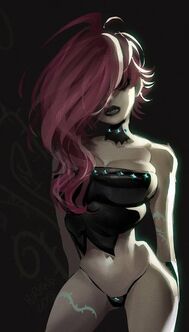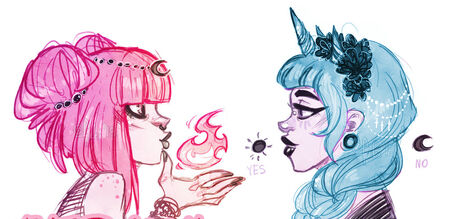Apperance[]
They are both twins but because they don't want to be completely the same, they dye their hair different colors. Cotton goes for the different tones of blue while her much childish sister goes for pink/purple hues. No one knows their real names as they go by Cotton & Candy and enjoy dressing in pastel goth type fashion. Both females are covered in piercings and tattoos of all sorts consisting of punkish and grunge styles and though both have different hair colors, their hair styles never stay the same for long.
Behavior/Personality[]
Cotton is a lot like her twin sister, Candy but with a more mature outlook (though you wouldn't know it) she is the more adult one between the two and at a higher cynical level with a warped view of life and very little surprises her. She is pesimestic unless on drugs which helps her lighten up and enjoy herself better. Untrusting, quick to betray others and easy to use tricks to get the upperhand she only loves herself and Candy.
Candy is a much sweeter version of Cotton, her view on life is just as warped as her twin but with a strange cheery outlook and a dark optomism. She enjoys being childish and likes being told what to do by her sister, only listening to her as she can be a bit of a pill to handle when she gets too hyper or doped up on uppers. A much bigger risk taker and for her it's all about causing chaos and having as much fun as possible while wrecking as much shit as possible.
Roleplay Allignment[]
Chaotic Neutral[]
A chaotic neutral character follows his or hers own whims. He/she is an individualist first and last. They will values their own liberty but doesn't strive to protect others' freedom. They will attempt to avoid authority, resents restrictions, and challenges traditions. A chaotic neutral character does not intentionally disrupt organizations as part of a campaign of anarchy. To do so, he or she would have to be motivated either by good (and a desire to liberate others) or evil (and a desire to make those different from himself suffer). A chaotic neutral character may be unpredictable, but his or her behavior is not totally random. They are inot as likely to jump off a bridge as to cross it.
Chaotic neutral is the best alignment you can be because it represents true freedom from both society's restrictions and a do-gooder's zeal.
Chaotic neutral can be a dangerous alignment when it seeks to eliminate all authority, harmony, and order in society.
A list of Ten Commandments for a chaotic neutral religion may look like this:
1. You shall lie to promote your freedom.
2. You shall not kill the innocent.
3. You shall not murder.
4. You shall help the needy if such action promotes your freedom.
5. You shall honor no authority above yourself.
6. You shall break the law whenever convenient.
7. You shall not betray others unless your life is in jeopardy.
8. You shall not aid enemies of freedom or those who promote law.
9. You shall pursue pleasure.
10. You shall promote unlimited freedom for yourself.
Class[]
Wiccans:
Pagan Witchcraft, is a contemporary Pagan new religious movement. It was developed in England during the first half of the 20th century and was introduced to the public in 1954 by Gerald Gardner, a retired British civil servant. Wicca draws upon a diverse set of ancient pagan and 20th century hermetic motifs for its theological structure and ritual practice.
Wicca has no central authority. Its traditional core beliefs, principles and practices were originally outlined in the 1940s and 1950s by Gardner and Doreen Valiente, both in published books as well as in secret written and oral teachings passed along to their initiates. There are many variations on the core structure, and the religion grows and evolves over time. It is divided into a number of diverse lineages, sects and denominations, referred to as traditions, each with its own organizational structure and level of centralisation. Due to its decentralized nature, there is some disagreement over what actually constitutes Wicca. Some traditions, collectively referred to as British Traditional Wicca, strictly follow the initiatory lineage of Gardner and consider the term Wicca to apply only to similar traditions, but not to newer, eclectic traditions.
Wicca is typically duotheistic, worshipping a Goddess and a God. These are traditionally viewed as the Moon Goddess and the Horned God, respectively. These deities may be regarded in a henotheistic way, as having many different divine aspects which can in turn be identified with many diverse pagan deities from different historical pantheons. For this reason, they are sometimes referred to as the "Great Goddess" and the "Great Horned God", with the adjective "great" connoting a deity that contains many other deities within their own nature. These two deities are sometimes viewed as facets of a greater pantheistic divinity, which is regarded as an impersonal force or process rather than a personal deity. While duotheism or bitheism is traditional in Wicca, broader Wiccan beliefs range from polytheism to pantheism or monism, even to Goddess monotheism.
Wiccan celebrations encompass both the cycles of the Moon, known as Esbats and commonly associated with the Goddess, and the cycles of the Sun, seasonally based festivals known as Sabbats and commonly associated with the Horned God. An unattributed statement known as the Wiccan Rede is a popular expression of Wiccan morality, although it is not accepted by all Wiccans. Wicca often involves the ritual practice of magic, though it is not always necessary.
Fighting Style[]
Weapon of Choice[]
Allies/Enemies[]
Background[]
APPROVED BY[]
~Two approvals will be needed IE: Chairmen Tasanagi, Chariman Ryoji













